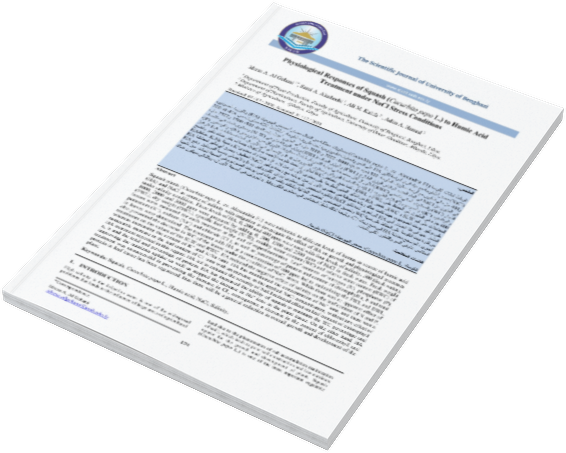Physiological Responses of Squash (Cucurbita pepo L.) to Humic Acid Treatment under NaCl Stress Conditions
DOI:
https://doi.org/10.37376/sjuob.v33i2.260Keywords:
Salinity, Squash, Cucurbita pepo L, Humic acid, NaClAbstract
Squash plants (Cucurbita pepo L. cv. Alexandria F1) were subjected to different levels of humus as source of humic acid (HA) and NaCl as source of salinity with irrigation to investigate the effect of HA on growth and physiological processes under salinity condition. Three levels of HA: 0, 200 and 400 ppm were used with four levels of salinity: 500 (fresh water), 1000, 2000 and 3000 ppm were prepared by adding 0, 500, 1500 and 2500 ppm of NaCl in fresh water. Fresh weight (FWL), dry weight (DWL), specific leaf weight (SLW), midday water content (WC) and relative water content (RWC) of leaves were measured for each treatment at the end of experimentation. Leaf contents of nitrogen (N), phosphorus (P), potassium (K+), sodium (Na+) and chloride (Cl−), as well as percentage of protein and content of chlorophyll a, b and total in leaves were determined. The treatment with HA at a concentration of 400 ppm led to maintaining the FWL and DWL, also prevented the decrease in WC of the leaves under the condition of NaCl stress. While there was no apparent effect of treatments on the values of the SLW and RWC. HA reduced the negative effect of salinity on the leaf content of N and P, whereas increasing the content of K+ and K:Na ratio. HA has maintained the concentration of Na+ ions, and there was a noticeable increase in the leaf content of Cl- ions with an increase in the applied NaCl concentration, without any effect of HA treatment reported in this regard. HA led to enhance the severity of NaCl reduced effect on leaf content of chlorophyll a, b and the total and percentage of protein. HA has increased the ability of squash to maintain the WC percentage and improving the nutrients uptake as well as stopped the increase in Na+ ions in the plant tissue. On the other hand, HA treatment was unsuccessful in preventing the increase in Cl-, consequence a decrease in the content of chlorophyll and protein in leaf tissue has been registered, thus there will be a general reduction in overall growth and development of the plant.
Downloads

Downloads
Published
How to Cite
Issue
Section
License

This work is licensed under a Creative Commons Attribution-NonCommercial-NoDerivatives 4.0 International License.


















